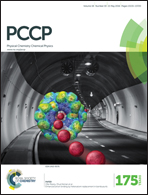Conceptual design of tetraazaporphyrin- and subtetraazaporphyrin-based functional nanocarbon materials: electronic structures, topologies, optical properties, and methane storage capacities†
Abstract
A large variety of conceptual three- and fourfold tetraazaporphyrin- and subtetraazaporphyrin-based functional 3D nanocage and nanobarrel structures have been proposed on the basis of in silico design. The designed structures differ in their sizes, topology, porosity, and conjugation properties. The stability of nanocages of Oh symmetry and nanobarrels of D4h symmetry was revealed on the basis of DFT and MD calculations, whereas their optical properties were assessed using a TDDFT approach and a long-range corrected LC-wPBE exchange–correlation functional. It was shown that the electronic structures and vertical excitation energies of the functional nanocage and nanobarrel structures could be easily tuned via their size, topology, and the presence of bridging sp3 carbon atoms. TDDFT calculations suggest significantly lower excitation energies in fully conjugated nanocages and nanobarrels compared with systems with bridging sp3 carbon fragments. Based on DFT and TDDFT calculations, the optical properties of the new materials can rival those of known quantum dots and are superior to those of monomeric phthalocyanines and their analogues. The methane gas adsorption properties of the new nanostructures and nanotubes generated by conversion from nanobarrels were studied using an MD simulation approach. The ability to store large quantities of methane (106–216 cm3 (STP) cm−3) was observed in all cases with several compounds being close to or exceeding the DOE target of 180 cm3 (STP) cm−3 for material-based methane storage at a pressure of 3.5 MPa and room temperature.


 Please wait while we load your content...
Please wait while we load your content...